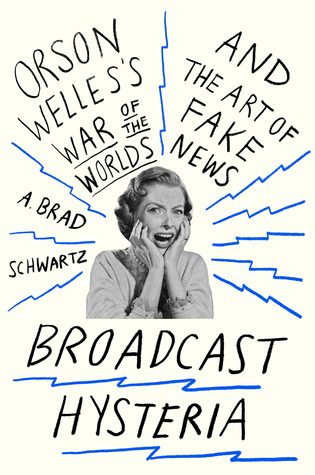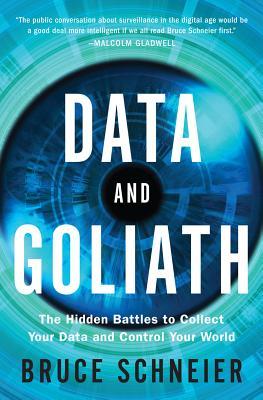 Broadcast Hysteria: Orson Welles's War of the Worlds and the Art of Fake News by A. Brad Schwartz
Broadcast Hysteria: Orson Welles's War of the Worlds and the Art of Fake News by A. Brad Schwartz Formats available: hardcover, paperback, ebook, audiobook
Pages: 352
Published by Hill and Wang on May 5th 2015
Purchasing Info: Author's Website, Publisher's Website, Amazon, Barnes & Noble, Kobo, Bookshop.org
Goodreads
The enthralling and never-before-told story of the War of the Worlds radio drama and its true aftermath
On the evening of October 30, 1938, radio listeners across the United States heard a startling report of a meteor strike in the New Jersey countryside. With sirens blaring in the background, announcers in the field described mysterious creatures, terrifying war machines, and thick clouds of poison gas moving toward New York City. As the invading force approached Manhattan, some listeners sat transfixed, while others ran to alert neighbors or to call the police. Some even fled their homes. But the hair-raising broadcast was not a real news bulletin-it was Orson Welles's adaptation of the H. G. Wells classic The War of the Worlds.
In Broadcast Hysteria, A. Brad Schwartz boldly retells the story of Welles's famed radio play and its impact. Did it really spawn a "wave of mass hysteria," as the New York Times reported? Schwartz is the first to examine the hundreds of letters sent to Orson Welles himself in the days after the broadcast, and his findings challenge the conventional wisdom. Few listeners believed an actual attack was under way. But even so, Schwartz shows that Welles's broadcast became a major scandal, prompting a different kind of mass panic as Americans debated the bewitching power of the radio and the country's vulnerability in a time of crisis. When the debate was over, American broadcasting had changed for good, but not for the better.
As Schwartz tells this story, we observe how an atmosphere of natural disaster and impending war permitted broadcasters to create shared live national experiences for the first time. We follow Orson Welles's rise to fame and watch his manic energy and artistic genius at work in the play's hurried yet innovative production. And we trace the present-day popularity of "fake news" back to its source in Welles's show and its many imitators. Schwartz's original research, gifted storytelling, and thoughtful analysis make Broadcast Hysteria a groundbreaking new look at a crucial but little-understood episode in American history.
My Review:
This was scary all right, but not in the way that I originally thought. Then again, the original broadcast of the War of the Worlds in 1938 wasn’t actually as scary as anyone thought. At least not that night, 77 years ago today.
The newspaper coverage the next day had all the chills and thrills that anyone could possibly have imagined. And very little of it seems to have been true. Instead, the newspapers latched onto the sensational aspects and magnified them out of proportion, with each newspaper account adding more “details” to the one before, until the original incident became buried in an avalanche of sensationalized but fake news.
Today we would turn to snopes.com to see if the whole thing was a hoax or not. But in 1938 the internet hadn’t been invented yet, and TV was in its infancy, if not still mostly in its gestational stage. Your news choices were the newspaper, the radio, or the rumor mill.
In the case of Orson Welles’ broadcast of the War of the Worlds, the newspapers amplified the rumor mill until the story reached the level of myth – we all believe there was a mass panic during the October 30, 1938 radio broadcast, when there wasn’t really a mass anything.
For one thing, Orson Welles’ Mercury Theatre on the Air didn’t ever have a mass audience. It only had about a 3% share of the radio audience. Mercury Theatre ran opposite an extremely popular program, one that ironically starred a ventriloquist and his dummy, Edgar Bergen and Charlie McCarthy.
The story in Broadcast Hysteria is itself ironic. While it does provide background on Welles’ creation of the broadcast, the place where this story really puts its emphasis is on the aftermath. It also does a terrific job of explaining what it was that those people who did believe, even briefly, believed in, and why they believed it.
From the description of radio broadcasting techniques, and a look at world conditions at the time, a picture very different from the one of mass, uneducated panic emerges.
One of the aspects that fascinated this reader was the prevalence of re-enacted news events accepted as the truth. This was a standard practice in broadcast journalism at the time. To us it automatically sounds faked – a re-enactment is not the same as a recording of the same event. The re-enactment inevitably inserts some dramatic license to make its packaged story flow. That some of the same voice actors from the news re-enactments were part of the War of the Worlds did add to the verisimilitude.
But even more telling was what people believed. Based on information that has recently been pulled from various archives, it looks like only a third of the people who believed at all believed or even heard anything about Mars and Martians. In 1938, with World War II about to erupt and World War I still a very recent memory, a lot of people believed they were hearing about a perfectly terrestrial, albeit terrible, invasion of the U.S. by Germany or the growing Axis Powers. And most of the rest who believed something thought the problem was a meteor strike. Again, something quite plausible.
Like a lot of us who use television as the background soundtrack of our lives, many people who were listening to radio were not paying attention to every single word. It was on in the background, and they listened more intently when something grabbed their attention. So even people who were listening were not actively listening all the time. And without pictures, their minds filled in the blanks with things that made sense, like a European invasion or a meteor.
The story here is that the newspapers sold a lot of issues by playing up the sensationalism of the story. If it sounds like modern “clickbait”, it should. While there was some somewhat scientific research on the aftermath of the broadcast, the research seems to have been designed to confirm the biases of the researchers, and rejected any data that did not fit the result they wanted.
The fears at the time, in 1938, were that the mass panic supposedly created by the fake broadcast showed that America would be susceptible to mass propaganda in the same way that Germany and Italy had been. Instead, the data showed that propaganda didn’t really work that way, but the published reports ignored their own data.
So instead of a story about the mass panic, the one that I expected, instead we have a story about the rise of fake news, and we see just how seductive it can be. That’s actually more frightening than any invasion from Mars.
Reality Rating A-: The parts of this story that shine are the parts that get into the making of the broadcast and its aftermath. The world of radio broadcasting was different than we imagine, but in some ways the manner in which the news is made hasn’t changed all that much. The irony is that some of the worst changes are the result of War of the Worlds, not the non-existent panic of the broadcast, but the very real panic created by the newspaper coverage.
One of the reasons this book is sticking with me is that the comparisons to now are all too easy to make. In 1938, newspapers were tried and true, and radio was the new kid on the block. While that seems old fashioned now, it seems new again when the book describes all of the charges that were leveled at radio broadcasting at the time. Radio was new, it was immediate, it was available everywhere, and the drastic change in the way that people consumed media frightened people. All the same charges about corrupting morals and leading to violence that have been charged against TV, movies, video games and the internet in general were all leveled against radio at that time.
This is a fascinating study for anyone interested in mass communication and the uses and abuses to which it can be put.
One final note. As I said above, all the charges that every new media rots the mind were first leveled at radio. But one comment I found eerily prescient. A Tennessee publisher warned in 1932 that one day “newspapers will be nothing but a memory on a tablet…” And so they are.

 Grant Park by
Grant Park by  A Vigil of Spies (Owen Archer, #10) by
A Vigil of Spies (Owen Archer, #10) by  The story in this 10th book in the
The story in this 10th book in the 

 Owen makes an interesting and effective investigator. While he moves within all of these worlds, he is not a part of any of them. He is a soldier, but he works for the church. His wife is a respected master in the city, but he is not a member of any of the craft guilds. For a one-eyed man, he sees very clearly indeed. And because he is not partial to any of the groups involved, he is able to trace a clear path to the real killer without being blinded by shared interests or family ties.
Owen makes an interesting and effective investigator. While he moves within all of these worlds, he is not a part of any of them. He is a soldier, but he works for the church. His wife is a respected master in the city, but he is not a member of any of the craft guilds. For a one-eyed man, he sees very clearly indeed. And because he is not partial to any of the groups involved, he is able to trace a clear path to the real killer without being blinded by shared interests or family ties. Data and Goliath: The Hidden Battles to Collect Your Data and Control Your World by
Data and Goliath: The Hidden Battles to Collect Your Data and Control Your World by